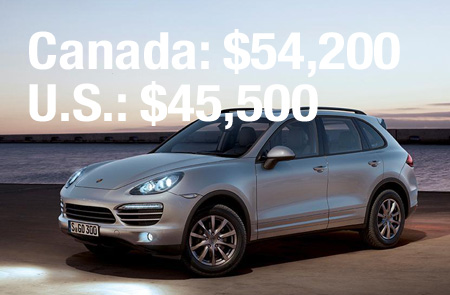The Crank: Is it deja vu all over again for crossborder new car buyers?
By John LeBlanc
As the Canadian dollar soars towards parity with the American greenback, is it deja vu all over again for new car buyers? Two-and-a-half years ago in the fall of 2007, the Canadian dollar reached an all-time high, peaking at $1.10 U.S. retailers were caught off guard. The disparity between Canadian and U.S. new car prices was dramatic, with some high-end cars ending up thousands of dollars cheaper south of the border. Canadians reacted strongly, importing a record of over 240,000 new U.S.-market cars in 2008.
But now that our dollar is virtually worth the same as theirs – and likely to stay that way for a while according to financial experts – will Canadian new-car shoppers once again look across the border for better deals on new wheels? As the Canadian dollar has steadily climbed the last few months, automakers have kept Canadians coming into their showrooms with traditional cash and financing incentives instead of taking the more drastic measure of dropping prices. In fact, for the fourth straight month in March, Canadians bought more new cars than the year before; up 14 per cent over this time last year.
But after coming out of one of the deepest sales slumps since the end of the Second World War, new car retailers are in no mood to lose customers to the U.S. again. This time, they are being more proactive in narrowing the cross-border price gap. One of the first retailers to react was Porsche Canada.It Its Canadian Currency Credit is a factory-to-dealer incentive, available on all 2010 Porsche models whether you buy, lease or finance. For example, under the new program, the starting price for Porsche’s most popular model, the Cayenne, is now $54,200. That’s substantially less than its 2007 price of $60,100, but still more than its US$45,500 cost south of the border.
Porsche Canada spokesperson Laurance Yap argues that most Canadian Porsches have more standard equipment than comparable U.S. models. Plus Canadians still enjoy the second least-expensive Porsches in the world. “We are in a unique situation here. We happen to be beside the largest and least expensive Porsche market in the world, the United States,” said Yap.
Volvo Canada similarly has introduced its Currency Cash incentive program across all its models, with as much as $9,000 off its top-of-the-line $51,995 XC90 SUV. But that’s still more than $5,000 above the U.S. price. Geoff Dickens, international sales manager at St. Laurent Volvo in Ottawa, Ont. says, in his time selling Volvos, he’s never seen so many cash incentives across the lineup. And he thinks it’s a smart move by the automaker to retain customers.
Dickens admits he hasn’t seen that many customers using U.S. prices as a threat to buy cars south of the border instead of at his east-end Ottawa dealership yet. But he thinks if the loonie stays at par, customers will start to at least use that information as a bargaining tool.
“I’ve barely seen it so far, but I know it’s coming,” said Dickens.
Back when we saw a similar parity problem in 2007, the vehicles with the largest disparity between their U.S. and Canadian prices were mostly high-end luxury brands. So while there are currently plenty of incentives out there in the marketplace (i.e. Lexus is offering between $3,000 and $8,000 cash incentives) with most brands trying to keep the currnet sales momentum going, as this is being written, no other Canadian automakers are marketing them specifically as “currency” credits. So far.
Just as new car buyers asked in 2007, if you truly want the least expensive car in North America, is it worth the hassle of importing your next new car from the U.S.?
Despite the recent upswing in cash purchases, most new-car buyers still need financing. Canadians cannot qualify for American-based factory financing. And good luck finding an American dealer who will even consider taking your Canadian car or truck as a trade in.
If you decide not to pay a broker to source a U.S. car and do all of the paperwork, the time involved to do this on your own can be onerous. Can you afford the time off work for the several days it may take pick up your car? Can you arrange transportation to and from the U.S. dealer? Can you afford the travel costs?
If importing a new U.S. vehicle, you also need to check Transport Canada’s List of Vehicles Admissible from the United States to make sure your new vehicle is permitted, and can be modified to meet Canadian requirements. Then, if your vehicle can be imported, you must register it with Transport Canada’s Registrar of Imported Vehicles. Finally, you cannot license your vehicle in Canada until it is modified to meet Canadian requirements, and passes the federal inspection from RIV.
Of course, if the Canadian dollar stay at par for a lengthy period of time, Canadian new car retailers will be forced to evaluate (i.e. reduce) their prices. But this usually can only be done during a model year change over, not on a month-to-month basis. Until then, it looks like these so-called “currency cash” incentive programs are here to stay.
“If the dollar stays at par in May, we’ll definitely continue the program,” says Porsche’s Yap.






![[del.icio.us]](https://www.straight-six.com/wp-content/plugins/bookmarkify/delicious.png)
![[Digg]](https://www.straight-six.com/wp-content/plugins/bookmarkify/digg.png)
![[Facebook]](https://www.straight-six.com/wp-content/plugins/bookmarkify/facebook.png)
![[Google]](https://www.straight-six.com/wp-content/plugins/bookmarkify/google.png)
![[Reddit]](https://www.straight-six.com/wp-content/plugins/bookmarkify/reddit.png)
![[StumbleUpon]](https://www.straight-six.com/wp-content/plugins/bookmarkify/stumbleupon.png)
![[Twitter]](https://www.straight-six.com/wp-content/plugins/bookmarkify/twitter.png)
![[Email]](https://www.straight-six.com/wp-content/plugins/bookmarkify/email.png)